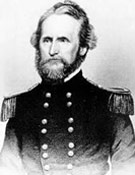Nathaniel Lyon
|
|
Nathaniel Lyon (July 14, 1818 - August 10, 1861) was the first Union general to be killed in the American Civil War and is noted for his action in the state of Missouri at the beginning of the conflict.
Lyon is a controversial figure in American history. Some credit his quick action and hard line unionism for stopping the Missouri secession movement while others question his influence peddling and his role in events such as the St. Louis Massacre, which inflamed many Missourians on the secession issue (See Missouri secession)
| Contents |
Early life and career
Lyon was born on a farm in Ashford, Connecticut. As a boy he hated farming. His relatives had fought in the American Revolution and he was determined to follow in their footsteps. In 1837 he applied to the United States Military Academy and graduated eleventh in his class in 1841.
He was assigned to the Second Infantry after graduation and served with them in the Seminole Wars and the Mexican-American War. Promoted to First Lieutenant for "conspicuous bravery in capturing enemy artillery" at the Battle for Mexico City, he was then posted to the frontier where he participated in the massacre of Native Americans at Clear Lake, California. After being reassigned to Fort Riley, Kansas, Lyon became a staunch abolitionist while serving in the border wars known as "Bleeding Kansas".
St. Louis arsenal
In 1861 Lyon was named an officer in the Second Infantry, which was assigned to the arsenal at St. Louis. A politically connected man with leanings toward the Radical Republicans, Lyon employed his friendship with Frank Blair to eventually have himself named commander of the arsenal. At the time the state of Missouri was relatively neutral in the dispute between North and South, but Governor Claiborne F. Jackson was a strong Southern sympathizer. When the Civil War broke out and President Abraham Lincoln called for troops to put down the Confederacy, Missouri was asked to supply four regiments. Jackson refused the request and ordered the Missouri State Guard to muster outside St. Louis under the stated purpose of training for home defense.
Lyon disguised himself as a farm woman to spy on the State Guard's camp and discovered that Jackson planned to seize the arsenal for Missouri troops. Lyon himself had been extensively involved in the St. Louis Wide Awakes, a pro-union paramilitary organization which he intended to arm from the arsenal and muster into the ranks of the federal army. Upon obtaining command of the arsenal Lyon armed the Wide Awake units under guise of night. Lyon had most of the weapons in the arsenal secretly moved to Illinois and on May 10 he led the Second Infantry to the camp, forcing its surrender. Riots broke out in St. Louis after Lyon marched his prisoners through the city. The event provoked the St. Louis Massacre of May 10, 1861 in which Lyons' troops opened fire on a crowd of civilians injuring at least 90 and killing 28. He was nonetheless promoted to Brigadier General and given command over the entire Army of the West.
In June, after meeting personally with Jackson in a futile attempt to resolve their differences, Lyon moved up the Missouri River and captured the state capital at Jefferson City. The elected Missouri State Government, under the guard of Sterling Price and the Missouri State Guard, retreated to the southwest. Lyon installed a pro-Union state government in its place and removed the state's Attorney General J. Proctor Knott, a unionist who had stayed behind. Lyon reinforced his army before moving southwest as well.
Battle of Wilson's Creek
By July 13 Lyon was encamped at Springfield, Missouri with about 6,000 Union soldiers. The Missouri State Guard, about 75 miles southwest of Lyon and under the command of Price, met with troops under Gen. Benjamin McCulloch near the end of July. The combined Confederate forces numbered about 13,000, formed plans to attack Springfield, and marched northeast on July 31.
The armies met at dawn a few miles south of Springfield on the morning of August 10 in what would become known as the Battle of Wilson's Creek. Lyon, who had already been wounded twice in the fighting, was shot in the heart and killed while dramatically rallying his badly outnumbered men.
Fate of Lyon's remains
In the confused aftermath of the Union retreat from Wilson's Creek, Lyon's body was mistakenly left behind on the battlefield and discovered by Confederate forces. It was briefly buried on a Union soldier's farm outside Springfield until it could be returned to Lyon's relatives. Eventually the remains were interred at the family plot in Phoenixville, Connecticut where an estimated crowd of 15,000 attended the funeral.
Lyon was slight of figure with a shabby appearance; his boots were often unpolished, his uniform was often faded, and his insignia were often tarnished. Nonetheless, the men under his command were said to have worshipped him. Lyon was known for his love of mustard, and was often seen by his troops to be slathering it on thick slices of bread, even in the midst of battle. He never married; it is often written that he bequeathed all his property to the federal government of the United States, but this is disputed.

